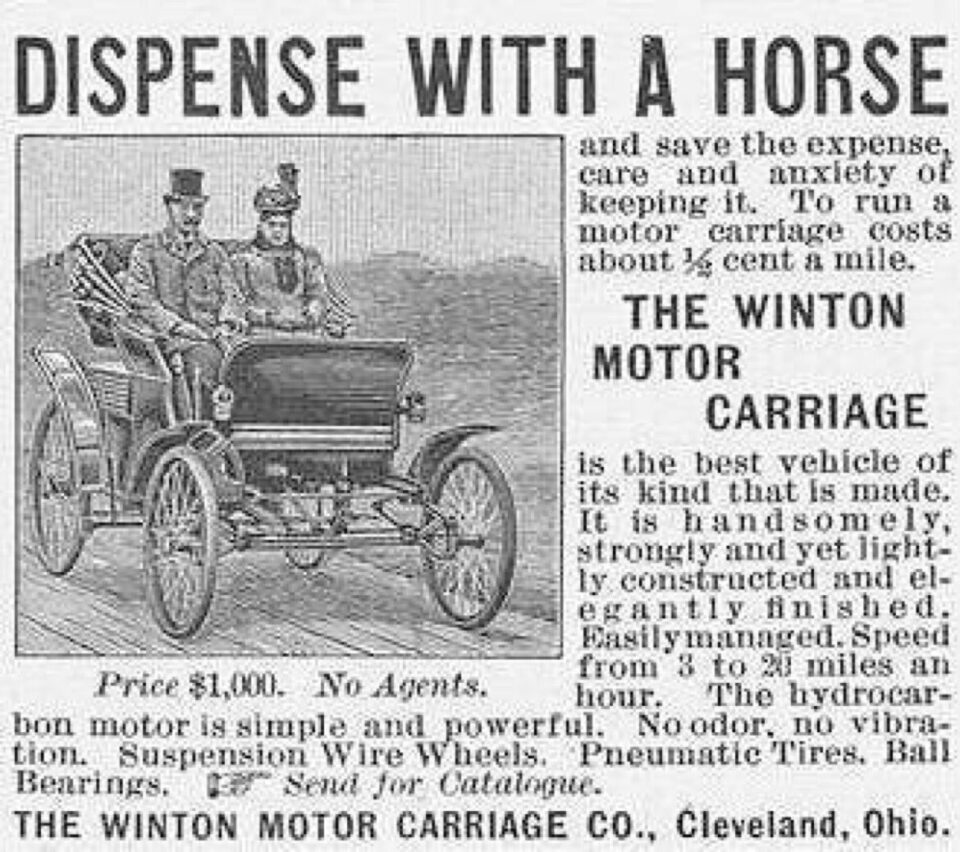“Rinuncia al cavallo evita le spese e l’ansia che porta averne uno“

🇬🇧 In 1898, a small advertisement in a newspaper read: “Give up a horse and avoid the expense and anxiety of having one. To drive a car, it takes half a cent per mile. The Winton Motor Carriage. it is the best vehicle of its kind created. It is very durable and at the same time light and elegant. You drive 3 to 20 miles per hour. The hydrocarbon engine is simple and powerful. No smell, no vibration, equipped with suspension for the wheels , tires and ball bearings “. Spot a century ago, to be exact, was put up by Alexander Winton, a Scottish bicycle maker who began building cars in 1896, becoming the largest motor vehicle manufacturer in 1900. The reason why there is no Winton car today is because in 1924 it stopped to switch to the production of stationary engines. The company was bought by General Motor in 1930 and became part of the Electro-Motive Corporation, which still works today. The advertisement was published in Scientific American, targeting the more cultured population in the same newspaper that would later tell the work of Einstein and Fermi. Sold for $ 1,000, today’s equivalent of $ 26,800, and only in 1908 would it rival Ford’s Model T, which sold for $ 825 (the equivalent of $ 19,900).
🇮🇹 Nel 1898, su un giornale una piccola inserzione recitava: “Rinuncia al cavallo evita le spese e l’ansia che porta averne uno. Per far camminare un’auto serve mezzo centesimo per miglio. La Winton Motor Carriage è il miglior veicolo creato del suo genere. È molto resistente e allo stesso tempo leggero e elegante. Percorrete dalle 3 alle 20 miglia ogni ora. Il motore a idrocarburi è semplice e potente. Nessun odore, nessuna vibrazione, dotata di sospensione per le ruote, pneumatici e cuscinetti a sfere”. Spot di un secolo fà, per l’esattezza, venne messo da Alexander Winton, uno scozzese creatore di bicilette che iniziò nel 1896 a costruire auto, diventando nel 1900 il più grande fabricante di autoveicoli. Il motivo per cui ad oggi non esiste alcuna auto Winton è perché nel 1924 poi si fermò per passare alla produzione di motori stazionari. L”azienda venne comprata da General Motor nel 1930 e divenne parte dell’Electro-Motive Corporation, che ancora oggi lavora. La pubblicità venne pubblicata sullo Scientific American, puntando alla popolazione più acculturata sullo stesso giornale che poi avrebbe raccontato i lavori di Einstein e Fermi. Venduta a 1.000 dollari, l’equivalente odierno di 26.800 dollari, e solo nel 1908 avrebbe avuto come rivale la Model T della Ford, venduta a 825 dollari (l’equivalente di 19.900 dollari).
